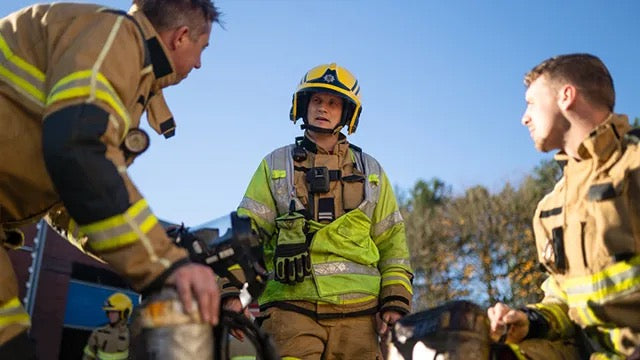CCT continues its round-up of this year’s TCCA Critical Communications World, which took place in Dubai
Welcome to the second part of our Critical Communications World 2024 recap. If you missed the first instalment, it is available here.
Following on from the topics covered in part one, it will come as no surprise that a key conversation during the conference was the ongoing move from narrowband to broadband. A large amount of content related to this took the form of national project updates, delivered by representatives from the countries in question.
One of the first of these was delivered by John Black, programme director of the UK’s Emergency Services Network programme. Discussing the development process (post-Motorola Solutions leaving the project in 2022), as well as timelines, he said: “A key issue for us is coverage… [and] our coverage journey is coming towards the end.
“When we started, EE had to build - to meet our contracted coverage requirements - around 650-700 new masts. Those masts are all built.
“There’s an additional 300 or so, which we call extended area services. We’re building those in conjunction with a separate strategic rural network programme, with the dual benefit of providing emergency services coverage, but also providing commercial coverage for the populations of those areas.”
Moving on from the coverage piece, Black continued by discussing what he called “testing at scale.” He said that the programme had taken advantage of the extra support given to it by Motorola post-2022, enabling it to focus on the EE network, RAN and backhaul solutions.
“What we’ve done over the last 18 months,” he said, “is go out to a whole range of the more ‘stressed’ situations [for testing]. Football stadiums are really good because you get a large number of people on a regular basis. Festivals, transport hubs, and other pressured situations as well.
“We’ve even done some simulations of previous terrorist activity, to see how the convergence of emergency services into a location has affected the network. That work has been hugely valuable, and we’ve learnt an awful lot about how a 3GPP standards-conforming MCX solution works under than kind of stress.”
The good news – in his words – is that it works. And also that the programme has found nothing to suggest “this technology won’t perform in the way we want it to with priority and pre-emption being effective.”
As well as Black’s presentation, day one also witnessed an update from a nation state at an earlier stage of its transition, delivered by the Swedish Civil Contingencies Agency (MSB).
Discussing network planning progress (as of this May), director of Rakel and command operating systems at MSB, Ronny Harpe, said: “Our final proposal for this project is not approved yet by the Swedish government. The key facts from the proposal is that we have to build a next generation mission critical network that provides the same services as today’s TETRA network.
“In Sweden, the network is supposed to support development of civil defence and total defence, and the need for secure and robust infrastructure is vital. Aiming to support end users in all different scenarios, from day-to-day business to crisis management, and even to the state of high alert.”
‘High alert’ in this context, he said, would be a state where Sweden “in some ways [is involved] in an armed conflict.”
He continued in his description of the aforementioned proposal, in particular that the Swedish state will have ownership of the core network and MCX platforms. And that it would build a dedicated radio access network to combine with commercial RANs.
“For this,” he said, “we propose that we have dedicated frequencies. When it comes to [being equal to] the existing TETRA network in terms of robustness, today’s network has seven days backup for 80 per cent of the infrastructure. The rest of the infrastructure has battery powered backups for about 36 to 48 hours.”
Moving onto timescale and the programme’s relationship with the Swedish government, he said: “The budget decisions have been reduced since last year. So, 36 million Swedish kronor this year, just to maintain the project that we have started, so we don’t have to close it all down and start over when the decision comes.”
Procurement for the core network has already taken place (Ericsson), as well as SIM card manufacturing.
“Though the bill states that the government sees the [urgency] for doing this technology shift, they know that if we don’t do it this time, we have to do re-investments for the existing TETRA network, for about two billion Swedish krona.”
Harpe continued by mentioning an alternative proposal for the network from Terracom, which is a Swedish state-owned company. This was investigated by a task force, in comparison to MSB’s proposal outlined above. “We foresee that this might be the year that we actually get a final decision from the government,” said Harpe.
Other national network updates came from FirstNet in the United States, Astrid in Belgium, SafeNet in South Korea and many more.
The ‘national roll-out’ sessions described above were focussed almost entirely on the future, with some of the plans being outlined measured out in decades. At the same time meanwhile, the conference also focussed on what might be referred to as ‘future’ technology, in the form of AI, satellite and 6G.
The latter two topics were dealt with in one go by VTT research professor Marko Hoyhtya, in his session looking at 6G-enabled satellite connectivity for remote regions. This was based on his organisation’s project work, as well as work with “state of the art satellite devices in Northern locations.”
Introducing the use of satellite in more general terms, he said: “[It’s] a technology which enables connections anywhere. Whether you are sailing far from the shore, flying high in the air, and of course, in remote areas.
“Typically, satellite systems are proprietary. So, in order to connect to Starlink system, you need to have a Starlink terminal. If you want to connect to OneWeb system, you need to have a OneWeb terminal. And so on.
“The big disruption that is coming is from 3GPP standardisation, which provides interoperability between the systems. Another big disruption is LEO [low Earth orbit satellite] constellations, meaning hundreds or even thousands [of satellites] in the same system.”
Moving on to talk about 6G, he stated that while previous broadband generations have been “optimised horizontally”, the latter will also have the “vertical aspect included.” Or to put it another way - following on from 3GPP’s current work -, satellite and aerial platforms will be integral to the 6G network architecture, alongside terrestrial.
“This is a very dynamic network,” he said. “You have moving satellites, temporary drone formations… in order to have good connections, you need to have dynamic resource management capabilities in place.”
Europe, he said, is planning to have its own multi-layer satellite/terrestrial system called Iris Square. The estimated cost for this – again, according to Hoyhtya – is about six billion Euro.
Moving onto AI, one particularly interesting presentation, taking place on the second day, looked at the technology in relation to TETRA. Delivered by HMF Smart Solutions’ Dr Amina Ayadi-Miessen, the session was titled ‘Running AI driven TETRA networks - from fiction to reality’.
Ayadi-Miessen discussed in potential uses of artificial intelligence in relation to TETRA, focussing in particular on security, operations, testing, and service.
Starting with the security piece, she said: “AI can be used to detect anomalies [in] user behaviour. For instance, we have a network where most of the time users are making group calls with a short duration. And suddenly we see duplex calls with a long duration, the AI is able to detect this as anomaly and raise and alarm.”
Moving onto operations, Ayadi-Miessen continued: “Learning from ‘big data’ which are available in the TETRA system, the AI is able to recognise changes, for instance in the base station, antenna, hardware and coverage. The advantage of using AI is that it is able to distinguish what component the changes are coming from.”











































Leave a comment
This site is protected by hCaptcha and the hCaptcha Privacy Policy and Terms of Service apply.